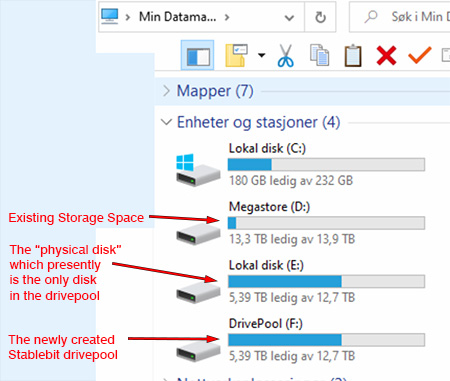Complete friggin n00b here. Askin all the stupid question.
This is one of them:
I have created a pool in Stablebit Drivepool (SBDP from now). I am migrating from Storage Spaces (SS from now) to SBDP because i didn't set the correct cluster size when i started using SS and as a result, i banged my head into the 16TB limit.
Something big had to be done. I realized i could do 1 of 2 things;
1. Make a new storage space with the correct cluster size and then remove disks from the old storage space to the new one.
2. Give SBDP a try, since I have read a lot of positive reviews about it. Many ppl seemed to consider SBDP to be considerably better than SS.
I choose option 2. So, as i said, I have created a pool in SBDP. At the moment it consists of just one 14TB disk. However, that will change when i choose to remove the rest of the HDD's from SS and add it to the new and glorious DrivePool pool
At the moment there is one thing that puzzles me; why do i see BOTH the drivepool and the local disk under My Computer? (see attached picture)
I would've expected the local disk to "disappear" and become a part of the pool. The way it is now makes me unsure about some things:
Which one (local disk or the pool) should i "interface" with?
Will more or less fatal errors occur if i use the wrong one?
Please bear with me here, please. I feel like i am taking a chance here; moving a lot of precious data and trying out a new system. I just need someone to reassure me and/or explain it to me as if I were a 10 year old
And please feel free to tell me all the ways DP is better than SS (and in which way) if that's the case.
Question
strangel
Hi all.
Complete friggin n00b here. Askin all the stupid question.
This is one of them:
I have created a pool in Stablebit Drivepool (SBDP from now). I am migrating from Storage Spaces (SS from now) to SBDP because i didn't set the correct cluster size when i started using SS and as a result, i banged my head into the 16TB limit.
Something big had to be done. I realized i could do 1 of 2 things;
1. Make a new storage space with the correct cluster size and then remove disks from the old storage space to the new one.
2. Give SBDP a try, since I have read a lot of positive reviews about it. Many ppl seemed to consider SBDP to be considerably better than SS.
I choose option 2. So, as i said, I have created a pool in SBDP. At the moment it consists of just one 14TB disk. However, that will change when i choose to remove the rest of the HDD's from SS and add it to the new and glorious DrivePool pool
At the moment there is one thing that puzzles me; why do i see BOTH the drivepool and the local disk under My Computer?
(see attached picture)
I would've expected the local disk to "disappear" and become a part of the pool. The way it is now makes me unsure about some things:
Please bear with me here, please. I feel like i am taking a chance here; moving a lot of precious data and trying out a new system. I just need someone to reassure me and/or explain it to me as if I were a 10 year old
And please feel free to tell me all the ways DP is better than SS (and in which way) if that's the case.

Edited by strangelchanged picture size
2 answers to this question
Recommended Posts
Join the conversation
You can post now and register later. If you have an account, sign in now to post with your account.